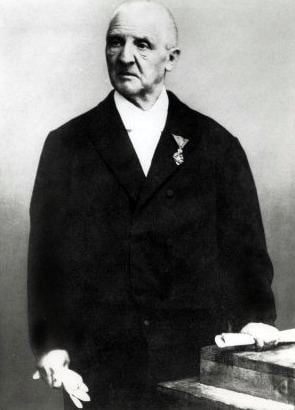Catalogue WAB 45 | ||
 | ||
Performed 2 May 1885 (1885-05-02): Kleiner Musikvereinssaal, Vienna | ||
The Te Deum in C major, WAB 45 is a setting of the Te Deum hymn, composed by Anton Bruckner for SATB choir and soloists, orchestra, and organ ad libitum.
Contents
History
Bruckner started work on his Te Deum from 3 to 17 May 1881, when he was finalising his Symphony No. 6. After finishing his next Symphony No. 7, Bruckner resumed work on his Te Deum on 28 September 1883. The vocal and orchestral score was completed on 7 March 1884. The ad lib. organ part was added on a separate score on 16 March 1884. The composer dedicated the piece A.M.D.G. "in gratitude for having safely brought me through so much anguish in Vienna."
The Te Deum was premiered in the Kleiner Musikvereinssaal in Vienna on 2 May 1885, with soloists Frau Ulrich-Linde, Emilie Zips, Richard Exleben, and Heinrich Gassner, with the choir of the Wiener Akademischer Richard Wagner Verein, and Robert Erben and Joseph Schalk substituting for the orchestra on two pianos. Hans Richter conducted the first performance with full orchestra on 10 January 1886 in the Großer Musikvereinssaal of Vienna.
Thereafter, there were almost thirty more performances within Bruckner's lifetime. The last performance, which Bruckner attended, was conducted by Richard von Perger at the suggestion of Johannes Brahms. On his copy of the score, Gustav Mahler crossed out "für Chor, Soli und Orchester, Orgel ad libitum" (for choir, solos and orchestra, organ ad libitum) and wrote "für Engelzungen, Gottsucher, gequälte Herzen und im Feuer gereinigte Seelen!" (for the tongues of angels, heaven-blest, chastened hearts, and souls purified in the fire!). The composer himself called the work "the pride of his life".
The first performance in the United States occurred at the Cincinnati May Festival on 26 May 1892. Theodore Thomas conducted the Chicago Symphony Orchestra, the Cincinnati May Festival Chorus and the soloists Corinne Moore-Lawson, Marie Ritter-Goetze, Edward Lloyd and George Ellsworth Holmes.
The draft version of 1881 and the first sketch of 1883 are stored in the archive of the Kremsmünster Abbey. The voice and orchestral score, and the ad lib. organ score of 1884 are stored in the archive of the Österreichische Nationalbibliothek.
Versions and editions
Setting
The work is set for SATB choir and soloists, orchestra (2 flutes, 2 oboes, 2 clarinets in A, 2 bassoons, 4 horns in F, 3 trumpets in F, alto, tenor and bass trombones, contrabass tuba, timpani in C and G, and strings), and organ ad libitum .
The setting is in five sections.
- "Te Deum laudamus" – Allegro, Feierlich, mit Kraft, C major
- "Te ergo quaesumus" – Moderato, F minor
- "Aeterna fac" – Allegro, Feierlich, mit Kraft, D minor
- "Salvum fac populum tuum" – Moderato, F minor
- "In Te, Domine speravi" – Mäßig bewegt, C major
Total duration: about 24 minutes.
The first section opens in blazing C major by the choir in unison, propelled by a powerful open-fifth pedal point by the organ and open-fifths motive in the strings. Thereafter, the soloists and the choir enter as the music moves through distinctly Brucknerian processes and modulations.
The second section in F minor ("Te ergo quaesumus") is serene and imploring in nature, featuring an expressive tenor solo and a solo violin.
The third section ("Aeterna fac"), in Bruckner's favoured key of D minor, is almost apocalyptic in its fury. Propelled by a rhythmic device, it draws on the full resources of the choir and orchestra before coming to an abrupt unresolved cadence.
The fourth section ("Salvum fac populum tuum"), which begins as a repeat of the second section, this time with women's voices accompanying the tenor, evolves, after a bass solo and a pedal point by the choir on "et rege eos, et extólle illos usque in aeternum", to the "Per singulos dies" sub-section, which recalls the fervour and energy of the opening.
The final section in C major, which begins with the solo quartet, culminates in a joyous fugue, followed by an impassioned chorale on the words "non confundar in aeternum", which is remarkably similar to the main theme of the Adagio of Symphony No. 7. The opening string figure returns, as the full ensemble carries the work to a powerful conclusion.
Note
In the 1890s Bruckner was aware that he might not live to finish his Symphony No. 9, and some commentators have suggested that the Te Deum could be used as a finale. However, Robert Simpson believed that not "even in the poor state of health and mind of his last few months of his life, [would Bruckner have] considered the use of the C major Te Deum as finale to a D minor symphony to be more than a makeshift solution," and that the link to the Te Deum was simply a matter of self-quotation more than anything else.
Draft version of 1881
There is a single issue of this draft version:
Final version of 1884
The first recording, was by Felix Gatz with the Bruckner-Chor & the Staatskapelle Berlin in 1927: 78 rpm disc Decca 25159 (only parts 1 & 2). This historic recording can be heard on John Berky's website.
During the Nazi era, Bruckner's Te Deum and Psalm 150 were ignored, because their existence contradicted the Nazi myth that exposure to Richard Wagner's music had freed Bruckner from ties to the church. It was not until after the war that Eugen Jochum brought attention to Bruckner's Te Deum and other sacred music, conducting several concerts and recordings. Herbert von Karajan and Bruno Walter soon followed suit.
Some of these postwar recordings:
There are more than 100 recordings of Bruckner's Te Deum, mainly together with a symphony or another choral work. According to Hans Roelofs, Jochum's recording of 1965 still remains the reference. Other excellent recordings, according to Hans Roelofs, are i.a. those by Rögner, Barenboim, Best, Rilling and Luna.
